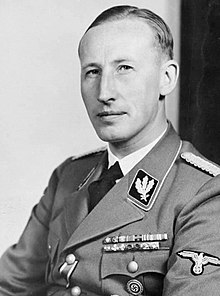
Back Reinhard Heydrich Afrikaans Reinhard Heydrich ALS راينهارد هايدريش Arabic راينهارد هايدريش ARZ Reynhard Heydrix Azerbaijani Райнгард Гайдрых Byelorussian Райнхард Хайдрих Bulgarian রাইনহার্ট হাইড্রিখ Bengali/Bangla Reinhard Heydrich Breton Reinhard Heydrich BS
Reinhard Heydrich | |
|---|---|
 Heydrich in 1940 | |
| Deputy Protector of Bohemia and Moravia | |
Acting Protector | |
| In office 29 September 1941 – 4 June 1942 | |
| Appointed by | Adolf Hitler |
| Preceded by | Konstantin von Neurath (Protector until 24 August 1943) |
| Succeeded by | Kurt Daluege (Acting Protector) |
| President of Interpol | |
| In office 24 August 1940 – 4 June 1942 | |
| Secretary-General | Oskar Dressler |
| Preceded by | Otto Steinhäusl |
| Succeeded by | Arthur Nebe |
| Director of the Reich Security Main Office | |
| In office 27 September 1939 – 4 June 1942 | |
| Appointed by | Heinrich Himmler |
| Preceded by | Office established |
| Succeeded by | Heinrich Himmler (acting) |
| Director of the Gestapo | |
| In office 22 April 1934 – 27 September 1939 | |
| Appointed by | Heinrich Himmler |
| Preceded by | Rudolf Diels |
| Succeeded by | Heinrich Müller |
| Additional positions | |
| 1939–1942 | Commander of the Einsatzgruppen |
| 1936–1942 | Deputy to the Reichsführer-SS [1] (de facto) |
| 1936–1939 | Director of the Sicherheitspolizei |
| 1934–1942 | Member of the Prussian State Council |
| 1931–1942 | Director of the Sicherheitsdienst |
| Personal details | |
| Born | Reinhard Tristan Eugen Heydrich 7 March 1904 Halle an der Saale, Prussia, German Empire |
| Died | 4 June 1942 (aged 38) Prague-Libeň, Protectorate of Bohemia and Moravia (now Prague, Czech Republic) |
| Manner of death | Assassination |
| Resting place | Invalidenfriedhof (Invalids' Cemetery), Berlin |
| Political party | Nazi Party |
| Spouse | |
| Children | 4 |
| Parents |
|
| Relatives | Heinz Heydrich (brother) |
| Signature |  |
| Nicknames | |
| Military service | |
| Allegiance | |
| Branch/service | |
| Years of service | 1922–1942 |
| Rank |
|
| Battles/wars | World War II |
| Awards | See service record section |
Reinhard Tristan Eugen Heydrich (/ˈhaɪdrɪk/ HY-drik; German: [ˈʁaɪnhaʁt ˈtʁɪstan ˈʔɔʏɡn̩ ˈhaɪdʁɪç] ⓘ; 7 March 1904 – 4 June 1942) was a high-ranking German SS and police official during the Nazi era and a principal architect of the Holocaust.
Heydrich was chief of the Reich Security Main Office (including the Gestapo, Kripo, and SD). He was also Stellvertretender Reichsprotektor (Deputy/Acting Reich-Protector) of Bohemia and Moravia. He served as president of the International Criminal Police Commission (ICPC, now known as Interpol) and chaired the January 1942 Wannsee Conference which formalised plans for the "Final Solution to the Jewish question"—the deportation and genocide of all Jews in German-occupied Europe.
Many historians regard Heydrich as one of the darkest figures within the Nazi regime;[6][7][8] Adolf Hitler described him as "the man with the iron heart".[5] He was the founding head of the Sicherheitsdienst (Security Service, SD), an intelligence organisation charged with seeking out and neutralising resistance to the Nazi Party via arrests, deportations, and murders. He helped organise Kristallnacht, a series of coordinated attacks against Jews throughout Nazi Germany and parts of Austria on 9–10 November 1938. The attacks were carried out by SA stormtroopers and civilians and presaged the Holocaust. Upon his arrival in Prague, Heydrich sought to eliminate opposition to the Nazi occupation by suppressing Czech culture and deporting and executing members of the Czech resistance. He was directly responsible for the Einsatzgruppen, the special task forces that travelled in the wake of the German armies and murdered more than two million people by mass shooting and gassing, including 1.3 million Jews.
Heydrich was mortally wounded in Prague on 27 May 1942 as a result of Operation Anthropoid. He was ambushed by a team of Czech and Slovak soldiers who had been sent by the Czechoslovak government-in-exile to kill him; the team was trained by the British Special Operations Executive. Heydrich died from his injuries on 4 June. Nazi intelligence falsely linked the Czech and Slovak soldiers and resistance partisans to the villages of Lidice and Ležáky. Both villages were razed; the men and boys age 14 and above were shot and most of the women and children were deported and murdered in Nazi concentration camps.
- ^ McNab 2009, pp. 17, 23 & 151.
- ^ Merriam Webster 1996, p. 1416.
- ^ a b c Ramen 2001, p. 8.
- ^ Snyder 1994, p. 146.
- ^ a b Dederichs 2009, p. 92.
- ^ Sereny 1996, p. 325.
- ^ Evans 2005, p. 53.
- ^ Gerwarth 2011, p. xiii.
© MMXXIII Rich X Search. We shall prevail. All rights reserved. Rich X Search